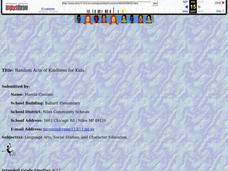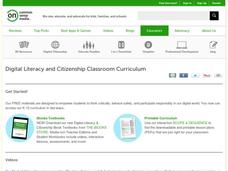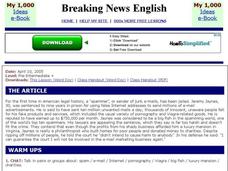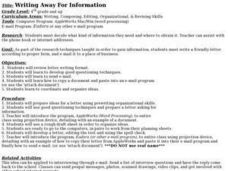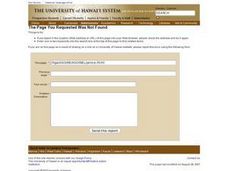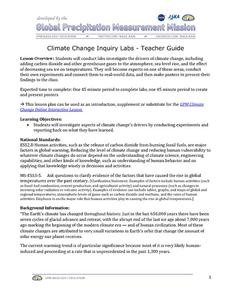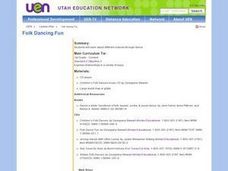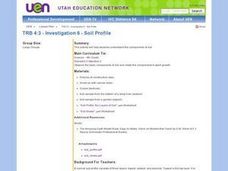Curated OER
Cartoons for the Classroom: You've Got Mail!
As the U.S. Postal System adjusts to virtual messaging, will snail mail slowly fade away? Examine the current phenomenon with your class through this political cartoon analysis, which has background information to give context for 2...
Curated OER
Random Acts of Kindness for Kids
Students examine the concept of kindness to others. They define kindness, listen to various stories about random acts of kindness, and create an e-mail chain describing their own acts of kindness that is sent around the world.
Curated OER
Random Acts of Kindness For Kids
Develop a world-wide, email chain on which class members can showcase their acts of kindness. After defining the meaning of random acts of kindness through discussion and through a reading of Random Acts of Kindness,...
Common Sense Media
Sending Email
Youngsters are introduced to the idea of communicating through e-mail, and gain important foundational knowledge for how to interact safely online.
Curated OER
Good E-mail Manners
Students discuss online e-mail safety and etiquette rules and how they should apply the same rules in cyberspace as they use when encountering strangers in the face-to-face world. They participate in mock situations and tell what the...
Read It Later, Inc
Can't read this now, I'll have to check it out later. A teacher's time is always limited. So often as we peruse the web for personal and professional content, we come across sites and information that we cannot immediately...
Curated OER
Breaking News English: Junk Mail
In this junk mail worksheet, students read the article, answer true and false questions, complete synonym matching, complete phrase matching, complete a gap fill, answer short answer questions, answer discussion questions, write, and...
Google
Interland
"Be Internet Awesome" is the motto in a super cool digital citizenship interactive created by Google. Interland is made up of four lands that explore the importance of digital safety and helps young Internet users to be alert, strong,...
Scholastic
Writing Letters of Gratitude
A lesson begins with a discussion on gratitude—what does it mean, and for who are learners thankful? Scholars share their thoughts and feelings then choose a community worker to which they wish to share their gratitude. Writers compose a...
Curated OER
Writing Away For Information
Students review the format used to write a friendly letter which they will use to write an e-mail. They use questioning techniques as they write a letter of inquiry using a number of drafts. Using a word processing program they develop...
Curated OER
Internet Fact Hunt at the "Fact Monster" Web Site- Hunt #35
In this Internet fact hunt worksheet, students access the "Fact Monster" web site to find the answers to 5 multiple choice questions. They answer questions about Canada, using e-mail, inventions, and Ecuador.
Curated OER
Pets Around the World
Students communicate via e-mail with other students to learn about pets, animals of interest , and geography from different parts of the world. Vocabulary focuses on rural, urban, and suburban areas.
Newseum
Are You a Publisher?: Free Press and You
What kinds of media do your pupils use to read and publish information? After a discussion about what publishing means, and about the freedom of the press, class members interview one or two other people about their publishing habits....
NASA
Climate Change Inquiry Lab
With global temperatures on the rise faster than ever recorded, the effects of a heating planet could be devastating. Allow learners to discover just what the world is in store for if the warming continues through a series of videos, a...
Curated OER
My Kind of Friend
Second graders read "Tacky the Penguin" by Helen Lester and chart Tacky's positive qualities that would make him a good friend to have. They identify the qualities they admire in a friend and role-play these qualities for the class.
Curated OER
Folk Dancing Fun
First graders discuss different kinds of music they have heard. They listen to a short selection of folk music and discuss where they think it is from. Using a globe, the teacher shows students where the music is from. They spread out on...
Curated OER
Hinges I, Hinges II
Students use their bodies in daily activities, by promoting a regular routine of using large and small motor skills, personal space, and boundary awareness. They move a scarf to the rhythm of the different kinds of music the teacher...
Curated OER
Investigation 6 - Soil Profile
Fourth graders study the components of soil. They observe the basic components of soil and relate the components to plant growth. They record color, texture, and kinds of materials on their profile log (light color, denser, grittier -...
Curated OER
Fish Hunt
Students prepare for a unit on aquarium maintenance by naming all the different kinds of fish they have seen either in aquariums, at home, or in the community. They use classroom computers to email other classrooms around the world for...
Curated OER
Surfin' the U.S.A. with Road Rabbit
Learners take virtual field trips to places in the U.S.A. in conjunction with the stops made by the class mascot, Road Rabbit. As Road Rabbit
travels to his destination(s) via snail mail, so do the students via the Internet.
Curated OER
Deciphering Community
Students explore the concept of a community. They identify and group various kinds of communities. Students create a concept map exemplifying their membership in different communities. They write a narrative describing their...
Curated OER
Investigation 7 - Plants In Soil
Fourth graders explain how the components of soil effect plant growth. They brainstorm different kinds of materials that plants could use for structural support. They design an experiment to show that plants can grow without soil.
Curated OER
Casserole Lab
Students participate in a lecture and lab explaining the qualities of a casserole, identifying the different kinds, the function of the ingredients and foods used in the preparation of the casserole.
Curated OER
Miniature Water Cycles
Students construct a model of the water cycle in action using two-liter pop bottles to build a terrarium. Locate examples of evaporation and condensation in the water cycle (e.g., water evaporates when heated and clouds or dew forms when...



